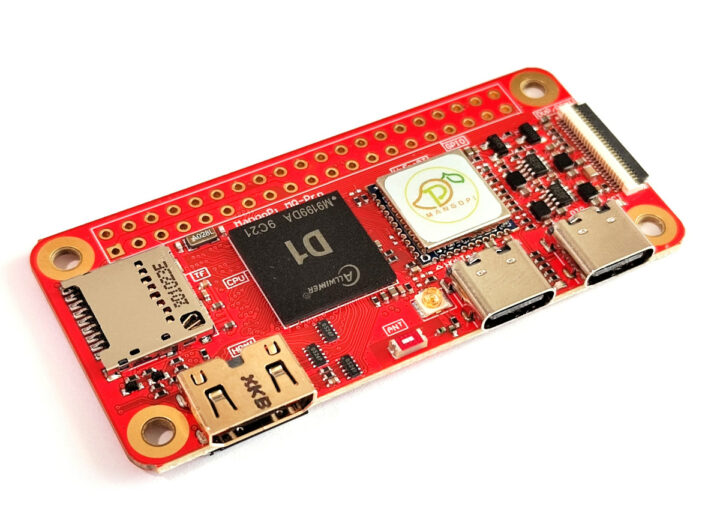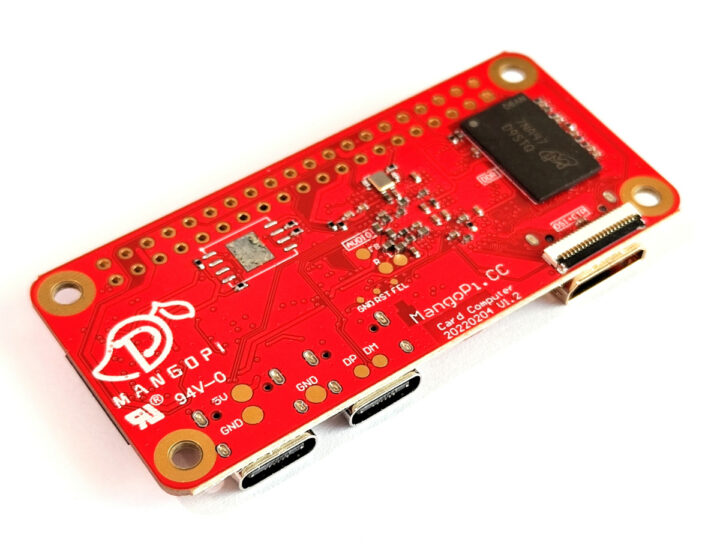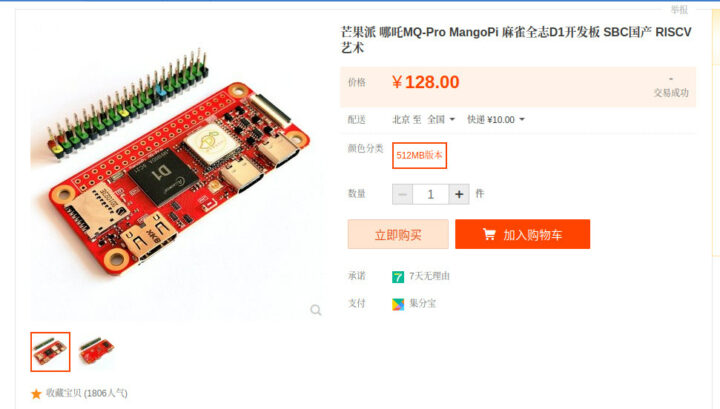MangoPi MQ Pro is an Allwinner D1 RISC-V SBC that offers an alternative to Raspberry Pi Zero W with the same form factor, and most of the same features including WiFi and Bluetooth connectivity
The board has been in the works for several months, but the MangoPi MQ Pro board can now be purchased for around $20 on Taobao with 512MB RAM, and I’d expect it to show up on Aliexpress and/or Seeed Studio within the next few weeks.
 MangoPi MQ Pro specifications:
MangoPi MQ Pro specifications:
- SoC – Allwinner D1 C906 RISC-V processor @ up to 1GHz with HiFi4 DSP, G2D 2D graphics accelerator
- System Memory – 512MB or 1GB DDR3L
- Storage – MicroSD card socket
- Display – mini HDMI 1.4 port up to 1080p60 or 4Kp30, 20-pin MIPI DSI, CTP, LVDS FPC connector
- Camera I/F – 24-pin DVP/RGMII connector
- Audio – Audio out pads
- Networking
- 2.4Ghz 802.11b/g/n WiFi 4 and Bluetooth 4.2 via RTL8723DS module + u.FL antenna connector
- Ethernet via expansion board connected to 24-pin connector
- USB – 1x USB OTG Type-C port, 1x USB host Type-C port
- Expansion – 40-pins Raspberry Pi compatible GPIO header
- Power Supply – 5V via USB Type-C port
- Dimensions – 65 x 30 mm
 Like other Allwinner D1 boards, the MangoPi MQ Pro can run the OpenWrt-based Tina Linux or Debian. You’ll find some resources and documentation on Github, but not everything has been shared yet as the hardware folder is empty, and so is the Tina Linux SDK. More details may eventually surface on the product page, and MangoPi provides frequent updates on its Twitter account.
Like other Allwinner D1 boards, the MangoPi MQ Pro can run the OpenWrt-based Tina Linux or Debian. You’ll find some resources and documentation on Github, but not everything has been shared yet as the hardware folder is empty, and so is the Tina Linux SDK. More details may eventually surface on the product page, and MangoPi provides frequent updates on its Twitter account.
The board can not handle all workload possible on the Raspberry Pi Zero W as the Allwinner D1 SoC lacks a 3D GPU. There’s a 4K capable H.265/H.264 video processing unit and the HDMI port supports 4Kp30 output, but most video player or media center programs will probably not support it. The board should work best for headless applications, or for HDMI applications with a simple 2D user interface.
The price is 128 CNY (or around $20) in China, but it should be a few dollars more on sites like Aliexpress. At that price, it does not even compete against the more powerful and better supported Raspberry Pi Zero 2 W ($15), but at least, it should be available and not suffer from the same shortage issues as Raspberry Pi hardware. MangoPi MQ Pro is also one of the most affordable Linux-capable RISC-V boards, follows Raspberry Pi Zero form factor, and comes with a nice set of features similar to the Sipeed Lichee RV dock kit.
Thanks to kxygk for the tip.

Jean-Luc started CNX Software in 2010 as a part-time endeavor, before quitting his job as a software engineering manager, and starting to write daily news, and reviews full time later in 2011.
Support CNX Software! Donate via cryptocurrencies, become a Patron on Patreon, or purchase goods on Amazon or Aliexpress






It’d be neat to see a device with this form factor ditch mini/micro-HDMI and put 4 USB-C ports along the side.
This will be slow but at least it can have 1 GB of RAM.
And what should the additional two USB-C ports do? At least with an D1 which features only two USB2 buses (both already exposed here on the existing USB-C ports) and is not capable of DisplayPort?
Device with this form factor, not D1.
I still don’t get it. Since replacing mini/micro-HDMI with USB-C would at least require native DisplayPort by the SoC in question?
Which SoCs you’d put on this form factor do this? RK3399 or RK3588 on a board of that size? And adding bridges like an Analogic ANX7688 (on the Pinephone for example) adds both BOM costs and complexity.
Perhaps the OP did not intend to have a display-output at all? At least to me having HDMI or any display-output in Pi Zero’s form-factor never made any sense and if one really needed to connect a display to it, one could always hook up a basic LCD-panel or something via the GPIO-pins.
Thought about that as well, then about SoCs with 4 independent USB buses (like Allwinner H3/H2+).
Just now realized that I might be way too biased since for my use cases internal USB hubs or ‘shared bandwidth’ are almost ‘broken by design’. Now thinking about the lack of affordable external USB hubs with multiple USB-C downstream ports…
Not every usb port is used for SS and external hubs are for me a no-go
Of course if you want to connect gigE or storage a hub is suboptimal for a usb equivalent of a RS232 i couldn’t care less
Sure, I’ve simply been both biased and confused. Since ‘4 USB-C ports’ on a device is something only found on expensive thingies like e.g. MacBooks. But that’s consumer electronics where a clueless user is expected to insert a 140W charger into any USB-C port, connect displays to any and so on.
An SBC sharing one Hi-Speed USB2 port over 4 USB-C ports lacking any real USB-C / USB PD features might be perfectly fine as long as expectations remain low.
Looks like unlike other Pi Zero format boards this one will be able to make use of pogo-pin based hats like the WaveShare PoE Ethernet/USB HUB HAT
I’m curious what kind of cameras they expect to be connected. The recently mentioned Arducam, would they work this? (Maybe the 16MP version)
I’m guessing compiling the library they require to work (libcamera) would be a chore
Nothing coming up yet on aliexpress.
Just wait … and wait … and wait. Mangopi has been annoucing this board for month as RSN. And I believe they suggest a retail price of $10 …
MangoPi has just confirmed it will become available on Aliexpress but did not provide a date yet.
I’ll keep checking, thank you.
Okay, first one showing: https://fave.co/3KO16Kr
$41 (USD) for the 512MB version. But it has free shipping. 🙂 That’s a pass until it gets down to $25 or so.
Someone got Debian xfce running on the nezha D1 … so I think a basic desktop can be done. Just no compositing. But the fact I am reduced to searching google images for answer instead of looking at specs or docs tells you where we are in maturity cycle 🙂 Looks like a promising board.
The LicheeRV’s default vendor provided Debian image boots to Xorg and LXDE. It is the same hardware, the D1 SoC and 512 MB of RAM. It is faster than you would expect, aside from the 2D acceleration seemingly not being used for now.
CNX might not allow my YouTube link, so you might no see this post.
Here is Lichee RV running Debian. You need to turn on subtitles for English translation.
https://www.youtube.com/watch?v=fwZqhd-o7uE